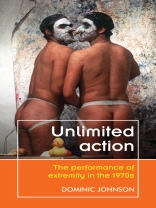Unlimited action concerns the limits imposed upon art and life, and the means by which artists have exposed, refused, or otherwise reshaped the horizon of aesthetics and of the practice of art, by way of performance art. It examines the ‘performance of extremity’ as practices at the limits of the histories of performance and art, in performance art’s most fertile and prescient decade, the 1970s. Dominic Johnson recounts and analyses game-changing performance events by six artists: Kerry Trengove, Ulay, Genesis P-Orridge, Anne Bean, the Kipper Kids, and Stephen Cripps. Through close encounters with these six artists and their works, and a broader contextual milieu of artists and works, Johnson articulates a counter-history of actions in a new narrative of performance art in the 1970s, to rethink and rediscover the history of contemporary art and performance.
Inhaltsverzeichnis
Introduction: Performance – action – extremity
1 The preferred ordeal
2 A criminal touch
3 The dirtying intention
4 Impossible things
5 The art of sabotage
Conclusion: Reckless people
Index
Über den Autor
Dominic Johnson is a lecturer in the Department of Drama at Queen Mary University of London












